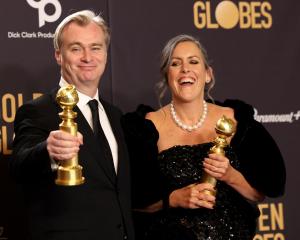
Set in 1960, it focuses on Don Draper, a glamorous up-and-comer with a double life and a secret past, and the smart, politically incorrect men around him.
But watching from a different perspective, there's a whole different story going on.
And it's all about the women: Peggy, Betty and Joan.
In their pointy bras and flouncy petticoats, the leading women - a secretary, a housewife and a sexy office den mother - might look like stars of television shows in bygone years.
They exist in a nonchalantly sexist world where men ask the new girl to shorten her skirt.
Agency partner Roger Sterling (John Slattery), for instance, advises Draper: "Remember, Don: When God closes a door, he opens a dress."
In pondering the question of what women want, Sterling sneers over a cigarette and a drink, "Who cares?" (And he's the classy one.)
But while they are marginalised, the women of Mad Men are no mere archetypes.
They are complicated, glamorous, ambitious and stifled in a way that women in 1960s television never were.
With 48 years of hindsight behind their creation, they are marginalised in a particularly subtle way, so viewers might not even realise they are riveted by their struggles.
One reason, according to the actresses who play them and their creator, Matt Weiner, is that they are really about women now.
Even in 1960, viewers couldn't relate to Ozzie and Harriet, Weiner says.
"The truth is: A lot of people were laughing at those shows then, at how unrealistic they were."
Perhaps it takes a show like Mad Men to allow viewers to appreciate the subtle conflicts of women's roles in the workplace and the family.
In Mad Men, the women, as well as the men, have public, private and secret lives.
Most dream of a fairy-tale life, married to a strong man and living in a country house.
To that end, the women always look lovely, in neatly coiffed hairdos, make-up and form-fitting dresses requiring military-strength - and, as the actresses say, sometimes painful - undergarments.
As January Jones, who plays Draper's wife, Betty, notes, "When you take the girdle off at the end of the day, everything sort of falls."
Veteran television writer Weiner says his main interest in writing the show was Draper (Jon Hamm).
He read authors of the period, such as J. D. Salinger and Norman Mailer, to inform Draper's world.
But he also read Helen Gurley Brown and Betty Friedan.
And as his mother, sister and wife are professional women, he says he quickly realised how dynamic the conflict in the female professional experience would be.
"I said, 'This is the rest of the show.'
"Don has a lot in common with all these women," he says.
"He's unable to express himself; he wants to be a different kind of person than he is. His image of himself is not really who he is.
"All these women are like that: If you buy into something, you have to live by the consequences."
Moss, Jones and Hendricks say what makes their characters so interesting is that they have so many sides to them.
At the same time, each operates at some level of denial.
Peggy, for instance, is bright, talented, ambitious and initially naive when she comes to work.
With Claudette Colbert-inspired "bumper bangs", she can't trade on her looks the way Joan and Betty do, and to be taken seriously she has to learn to play the game as the men do.
"Every step she takes, every meeting, every idea, every account is a new step for her," Moss says.
"Not only her, but the men around her. She takes her hard knocks, but she's definitely not one to make the same mistake twice."
It's important for her to play Peggy as she is, not what she represents, says Moss, who played the president's daughter on The West Wing and has appeared in several independent films.
"One of the great things about the show and the characters, why people love them and identify with them, is that they're just people, like you and me, in specific situations and in this time period."
Maintaining the facade of perfect wife and mother is important to Betty, but she's "not a Stepford wife", says Jones.
Betty, who is 28 in 1960, has a college education and a former career as a model.
She knows she has the life the others envy, but strange behaviour sends her to a psychiatrist.
"She has the ultimate realisation of luxury," Weiner says.
"She was in that world, but she's younger than [Draper] and she knows something now."
The question is, is she his child or his wife? And is that up to her?
It's rare in television, even now, to find rounded characters for women, says Hendricks, who plays Joan, the head secretary with a voluptuous Marilyn Monroe body and persona.
Wise in a Sex and the Single Girl way, Joan claims to want a husband but stays in a hopeless, long-term affair with the married Sterling.
"I think Joan's a little bit scared the fairytale's not there," Hendricks says.
"When you never finish a project, you can't be disappointed in it."
But at 31 in 1962, Joan knows she's quickly passing her prime.
Hendricks, Moss and Jones say the cast always has a good laugh at the impolitic dialogue in their first reading of an episode.
"Some of it just feels absurd," Hendricks says.
"You think, 'My God, you would never say that in public'."
But, they say, people still say shockingly sexist and politically incorrect things in public.
Jones, for instance, recently found life imitating a Mad Men scene.
She says she was in a lift with several men who were making the same sort of sexist remarks about women, as if there was no woman in the lift. - Lynn Smith
Mad Men is on on Prime at 8.30pm on Saturdays.












